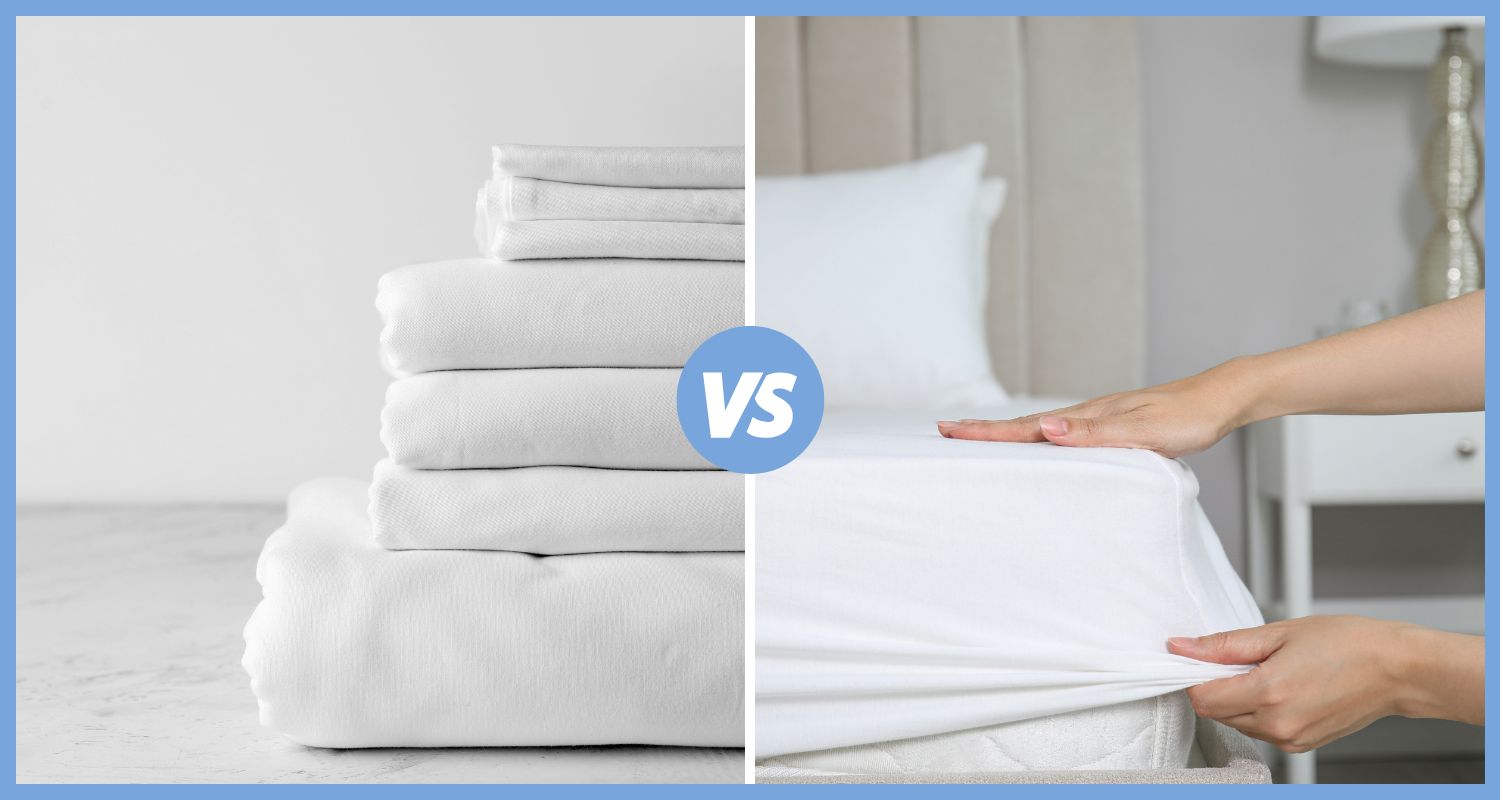Fitted Sheets vs Flat Sheets: Which One is Right for You?
A good night's sleep starts with the right bedding, and choosing between fitted sheets and flat sheets is an important part of making your bed as comfortable as possible. Both types of sheets have their own advantages, and understanding the differences can help you make the best choice for your needs.
In this article, we'll explore the features, benefits, and drawbacks of each type, and guide you in deciding which one suits you best.

What Are Fitted Sheets?
Definition and Features
Fitted sheets are designed with elastic edges that allow them to fit snugly over your mattress. They are tailored to match the shape of your mattress, ensuring a smooth and secure fit. The elastic helps keep the sheet in place, even if you move around a lot during the night.
Benefits of Fitted Sheets
One of the biggest benefits of fitted sheets is their ease of use. Thanks to the elastic edges, they stay firmly in place, meaning you don't have to worry about constantly re-tucking your bedding. They also provide a perfectly smooth surface, which helps in achieving a tidy and comfortable sleeping environment.
- Ease of use: Fitted sheets are quick to put on, saving you time when making the bed.
- Stays in place: The elastic edges prevent the sheet from slipping off, even for restless sleepers.
- Perfect fit: They provide a snug fit, creating a smooth and wrinkle-free surface for you to sleep on.
Drawbacks of Fitted Sheets
However, fitted sheets do come with some downsides. One of the most common complaints is how difficult they can be to fold neatly. Their elasticated corners make them tricky to fold in a compact, organised manner, which can be frustrating when storing them. Additionally, fitted sheets need to match the dimensions of your mattress precisely to ensure a good fit.
- Difficult to fold neatly: The elastic corners can make it challenging to fold the sheet properly.
- Sizing must match the mattress: You need to get the exact size to ensure it fits snugly on your mattress.
What Are Flat Sheets?

Definition and Features
Flat sheets, sometimes called top sheets, are rectangular sheets that can be placed either directly on top of the mattress or over a fitted sheet. They are versatile and often used as an additional layer of bedding between you and your duvet or blanket.
Benefits of Flat Sheets
Flat sheets offer several benefits, including versatility and ease of storage. They add an extra layer of protection for your duvet, which helps to keep your duvet cover cleaner for longer. Flat sheets are also easier to fold than fitted sheets, making them more convenient to store.
- Extra layer of protection: Flat sheets help keep your duvet or blanket cleaner by adding an extra barrier.
- Versatility: They can be used in different ways, either as a top sheet or even as a standalone cover in warmer months.
- Easier to fold and store: Flat sheets are simple to fold neatly, making them easy to store without taking up too much space.
Drawbacks of Flat Sheets
While flat sheets are versatile, they do require more effort to keep in place. They need to be carefully tucked in around the mattress, and they can shift during the night, which may require readjustment in the morning.
- Can shift during the night: Flat sheets can easily move out of place, especially if you toss and turn.
- Requires more effort to tuck in: Making the bed with a flat sheet involves more tucking and adjusting.
Differences Between Fitted and Flat Sheets
Fit and Placement
Fitted sheets are designed to fit snugly over the mattress, while flat sheets are meant to be tucked in or placed on top. Fitted sheets offer a secure, stay-in-place fit, while flat sheets offer more versatility in their placement.
Ease of Use
Fitted sheets are easier to put on the mattress but more challenging to fold. Flat sheets, on the other hand, are easier to fold and store but require more time and effort to tuck in properly when making the bed.
Comfort and Practicality
When it comes to comfort, fitted sheets provide a wrinkle-free surface that stays put, while flat sheets offer an extra layer that can enhance comfort by adding warmth or protection. The choice between the two ultimately depends on whether you prefer the convenience of fitted sheets or the layering benefits of flat sheets.
When to Choose a Fitted Sheet

Ideal Situations for Fitted Sheets
Fitted sheets are ideal for people who value ease and convenience. If you prefer a sheet that stays in place without needing constant adjustment, a fitted sheet is the best choice. They are also perfect for restless sleepers who move around a lot at night.
- If you prioritise ease of use: Fitted sheets are easy to put on and stay in place.
- For restless sleepers: The snug fit ensures the sheet won't come loose during the night.
Bed Types and Fitted Sheets
Fitted sheets work well with standard mattress sizes and are particularly useful for deeper mattresses or those with mattress toppers, as they ensure a tight fit that stays put.
When to Choose a Flat Sheet
Ideal Situations for Flat Sheets
Flat sheets are ideal if you enjoy layering your bedding or want to protect your duvet from getting dirty too quickly. They are also great for those who prefer a lighter layer in warmer weather or those who want an easier laundry routine.
- If you like layering: Flat sheets add an extra layer of comfort and protection.
- For easier laundry routines: They help keep your duvet or blanket cleaner, reducing the frequency of washing bulky items.
Bed Types and Flat Sheets
Flat sheets are versatile and can be used with any type of bed. They are especially useful in warmer climates where a lighter layer might be all you need at night.
Combining Fitted and Flat Sheets
Using Both for Maximum Comfort
Many people choose to use both fitted and flat sheets to enjoy the benefits of each. The fitted sheet provides a snug, secure layer over the mattress, while the flat sheet adds an additional layer of comfort and protection. This combination helps keep your duvet cleaner and provides extra warmth during colder months.
- How fitted and flat sheets can work together: Use a fitted sheet to cover the mattress and a flat sheet as a top layer for added comfort.
- Tips for combining them for a well-made bed: Ensure the flat sheet is neatly tucked in to prevent it from shifting during the night.
Final Thoughts
Ultimately, the choice between fitted and flat sheets comes down to your personal preference and bed-making habits. If you value convenience and a secure fit, fitted sheets are the way to go.
If you enjoy layering your bedding or want extra protection for your duvet, flat sheets might be the better option. Try experimenting with both types to find what works best for you and helps you achieve the perfect night's sleep.
FAQs
1. Do you need both fitted and flat sheets?
No, you don't necessarily need both. It depends on your preferences. Fitted sheets are great for keeping your mattress covered securely, while flat sheets can add an extra layer of comfort and protection.
2. How do you fold a fitted sheet properly?
Folding a fitted sheet can be tricky, but it helps to tuck the corners into each other to create a flat rectangle before folding it into a neat square. There are many tutorials available online that provide step-by-step guidance.
3. Which sheet type is better for hot sleepers?
Flat sheets are often better for hot sleepers as they provide a lighter layer that can be used on its own during warmer months. Fitted sheets are still necessary to cover the mattress, but using only a flat sheet as a top layer instead of a duvet can help keep you cooler.




